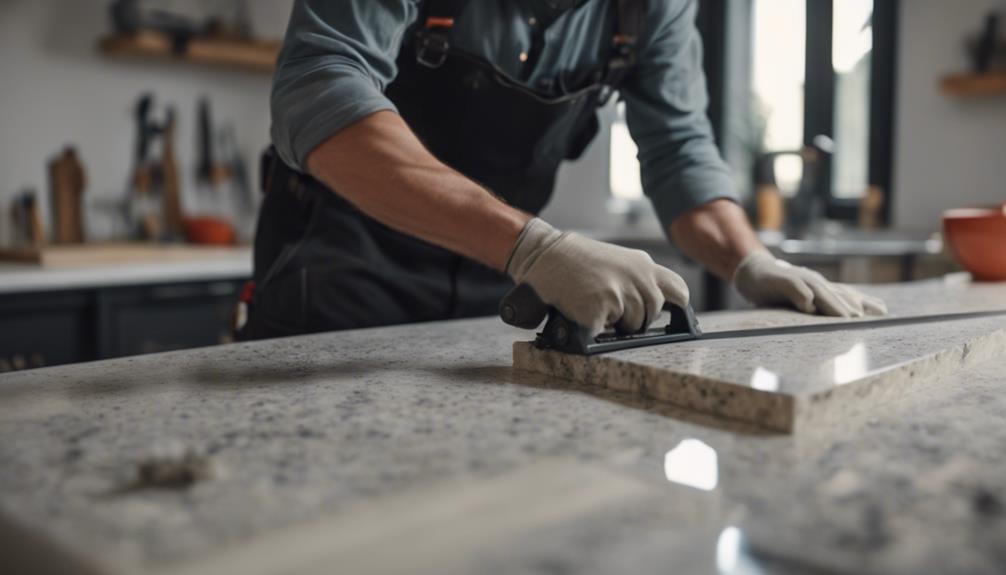Achieving a seamless granite countertop installation requires careful planning and attention to detail. It's not just about budgeting or choosing the right type of granite, but also about accurate measurements and precise execution. Each step is vital to ensure the end result meets your expectations.
Beyond the basic steps, there are further tips that can significantly enhance the quality of your installation. These insights help elevate a standard granite countertop installation to an outstanding one, by focusing on the nuances that make a big difference.
Clear, straightforward language is used to convey these points, avoiding clichés and ensuring a natural progression of ideas, all while adhering to British English spelling conventions.
Budgeting and Vendor Selection
Planning Your Budget
Kicking off a granite countertop project means you've got to have your numbers in order. A budget between £2,000 and £4,500 sets you up with a clear spending limit. Why does this matter? Well, you don't want to fall in love with a piece of granite that's way out of your price range.
The quality of the granite matters a ton because the better the quality, the heftier the price tag. It's all about finding that sweet spot where cost and quality meet.
Choosing the Right Vendor
Now, let's chat about picking a vendor. This is a biggie because the right vendor isn't just selling you granite; they're offering peace of mind with top-notch materials and expert fitting services. Look for vendors with a solid reputation, quality workmanship, and fair pricing.
This trifecta ensures a smooth sailing process. Also, the colour and pattern of the granite should be a good match for your kitchen's vibe. By shopping around, you can snag a deal that fits your budget without compromising on the quality you've set your heart on.
Why It All Matters
You might wonder, 'Why all the fuss about planning and picking?' Well, imagine spending your hard-earned money only to end up with a countertop that doesn't fit right or loses its charm in a few months.
A well-laid plan and a trustworthy vendor mean you'll get a stunning granite countertop that lasts for years, making every penny spent totally worth it. Plus, it's about making your kitchen a space you love. After all, it's where the magic happens—from morning coffees to midnight snacks.
Choosing the Right Granite Type
Choosing the Perfect Granite for Your Kitchen
When it comes to sprucing up your kitchen with a granite countertop, it's not just about picking a colour that matches your cabinets. There's a bit more to it. You've got options like slab, modular, prefabricated, and tile granite to think about. Each one has its own set of perks and quirks, so let's break it down, shall we?
Slab Granite: The Seamless Choice
Slab granite is the go-to for a custom, high-end look. Why? Because it's all about that seamless finish. Imagine having a countertop with barely any joins – that's what slab granite offers. It's cut to fit your kitchen, which means you get a sleek look without lots of seams breaking it up. But remember, while it's stunning, it might need a bit more of a budget.
Modular Granite: Easier to Install
Now, if you're after something a tad easier to handle, modular granite could be your mate. It comes in smaller, pre-cut pieces. This means you can often install it yourself, saving some pennies on labour. The catch? You might see more seams than with slab granite, but it's still a solid choice for a fab kitchen.
Prefabricated Granite: DIY Friendly
Fancy a bit of DIY? Prefabricated granite could be up your alley. It's ready to go with finished edges and all. It's a bit like a flat-pack furniture version of granite – designed to make your life easier. The downside is you've got less room to customise, and you'll need to work around the seams that come with it.
Tile Granite: Creative and Customisable
If you're all about getting creative, tile granite lets you play with patterns and designs. It's made up of smaller tiles, which means yes, more grout lines, but also more room for creativity. It's a way to add a unique touch to your kitchen. Just be ready for a bit more cleaning around those grout lines.
Why It Matters
Choosing the right type of granite isn't just about aesthetics; it also affects your kitchen's functionality and maintenance needs. Each type of granite offers different benefits, whether it's the seamless elegance of slab granite or the creative potential of tile granite. By understanding these differences, you can make a decision that not only looks good but also works best for your lifestyle.
Essential Materials for Installation
Essential Kit for Granite Countertop Fitting
To make sure your granite countertop fits perfectly, you need to have the right tools and materials at hand. This list includes silicone caulk, epoxy resin, a circular saw with a diamond blade, and of course, safety gear like gloves and goggles. These items are crucial for a smooth and successful installation.
Silicone caulk is your best friend when it comes to attaching the granite slabs firmly to the base cabinets. This ensures they stay put, adding to the stability and durability of your countertop. Epoxy resin is another hero of the story, great for gluing and fixing seams together. This is especially handy when you're working with more than one piece of granite, helping to create a seamless countertop surface. And when it comes to cutting the granite slabs to the exact size, nothing beats a circular saw armed with a diamond blade.
Safety First
During the installation, never forget the importance of safety. Wearing the right protective gear, like gloves and goggles, can shield you from any potential dangers. These tools and materials are not just vital for the installation phase; they also play a significant role in ensuring your granite countertop stands the test of time, looking as good as new for years to come.
Purchasing Granite Countertops
Exploring Your Options for Granite Countertops
Taking a closer look at the wide array of granite countertops on offer is key to finding one that fits both your budget and the look you're going for in your kitchen. Prices for these countertops can swing between £2,000 to £4,500, or £40 to £60 for every square foot. It's the quality that often dictates the price – the higher the quality, the steeper the cost. This definitely affects how much you'll end up spending.
To keep things affordable, it's smart to compare different types, qualities, and sizes. Besides, picking a granite type that elevates your kitchen's style is vital. With so many colours, patterns, and finishes to choose from, you can find the perfect match to complement your kitchen's vibe. By taking these factors into account, you're not just making your kitchen more practical – you're also boosting its overall look.
Why Quality and Style Matter
It all comes down to getting the best value and making sure your kitchen looks exactly how you envision it. High-quality granite isn't just about lasting longer; it's also about bringing a touch of elegance and durability to your kitchen. And when it comes to style, the right granite can transform your space. Imagine a sleek, modern kitchen with a jet-black granite countertop or a cosy, traditional space accented with a warm, speckled granite. The possibilities are endless, and finding the right one can make all the difference in creating a kitchen you love.
Final Thoughts on Choosing Granite Countertops
In the end, it's about balancing cost with what you really want for your kitchen. Remember, investing in a granite countertop is not just about today – it's about creating a space that you'll continue to enjoy for years to come. So, take your time, explore all your options, and choose a granite countertop that meets your needs in terms of both function and style.
Precise Measurement and Planning
Accurate measurement is the cornerstone of a successful granite countertop installation.
Ensuring precise planning will guarantee that the granite slabs fit flawlessly, leaving no room for errors.
Attention to detail in measurements and layout considerations will pave the way for a seamless and efficient installation process.
Measure Accurately for Precision
Measuring Your Countertop Space
First things first, you've got to get the measurements of your countertop area spot on. This means taking the length and width of the space where your new granite countertop will live. It's not just about making sure you buy enough granite; it's about ensuring that every piece fits together perfectly, like a jigsaw puzzle. Imagine trying to fit a piece into the puzzle, only to find out it's slightly too big or too small – frustrating, right? That's why nailing this step is crucial.
Planning Your Seam Placement
Next up, let's talk about seams. Nobody really likes to see them, but they're often a necessary part of having a granite countertop. The trick is to place these seams cleverly so they're as invisible as possible, blending in rather than standing out. It's a bit like when you're trying to make sure the pattern on your wallpaper matches up at the corners of your room. Getting this right means your countertops will look like one beautiful, unbroken piece of stone.
Ensuring a Level Surface
Before you even think about laying down your granite, there's something vital you need to check – whether your surface is level. It's a bit like setting up a pool table; if the floor's not level, you're going to end up with balls rolling in all the wrong directions. A countertop that's not level is a recipe for all sorts of problems down the line, from doors that won't close properly to gaps that seem to appear out of nowhere. Taking the time to ensure everything's level first can save you a world of hassle later on.
Plan Layout Efficiently
Planning Your Granite Countertop Layout
When you're getting ready to put in your new granite countertop, taking the time to plan out where everything will go is crucial. This isn't just about making sure it looks good, though that's important too. You need to measure everything carefully so you don't end up with a piece that doesn't fit or wastes too much material. It's all about using the granite slab as efficiently as possible.
Why Precise Measurements Matter
So, why bother with all this measuring and planning? Well, imagine you've got this beautiful slab of granite. You want to make sure you use every inch of it wisely, especially since it's not cheap. By measuring the area where the countertop will go, you can cut down on waste and ensure that the piece not only fits perfectly but also looks amazing. Plus, when you think about where the seams go or where the sink and appliances need to fit, you make the whole thing look seamless and integrated into your kitchen or bathroom beautifully.
The Importance of Seam and Cutout Placement
Let's talk about where those seams end up and how you cut out spaces for your sink or other appliances. These details might seem small, but they make a big difference in how the final product looks. You want the seams to be in places that aren't too obvious, so the countertop looks like one big, beautiful piece. And when it comes to cutouts, getting them just right means your sink or stove fits in snugly, without any awkward gaps or edges. It's these little things that can turn a nice countertop into a stunning one.
Consider Edge Options
Choosing the Perfect Edge for Your Granite Countertop
When you're looking to give your granite countertop that flawless finish, picking the right edge design is crucial. You've got options like the smooth bullnose, the sleek beveled edge, or the classic ogee. Getting the measurements spot on is key to ensure everything looks just right. It's all about planning ahead to make sure your countertop and cabinets look like they were made for each other.
Why Edge Details Matter
Going for a custom edge can really make your countertop stand out. It's a chance to add a personal touch, but it means you need to plan carefully to get it just right. The edge you choose isn't just about looks; it plays a big part in how practical your countertop is day-to-day. Taking the time to focus on these details makes a big difference to both the style and function of your kitchen.
Let's Talk About Functionality
Believe it or not, the edge of your countertop can affect how you use your kitchen. For example, a smoother edge like the bullnose is not just safe for kids, but it's also easy to clean. On the other hand, more intricate edges might catch crumbs a bit more but can add a touch of elegance. It's about finding the right balance for your lifestyle.
Proper Removal of Old Countertops
Getting Started on Countertop Removal
First things first, you'll want to turn off the water and disconnect all the plumbing fixtures. This step is crucial because, let's face it, nobody wants a mini flood in their kitchen while trying to upgrade it. Plus, it makes the whole transition to those shiny new granite countertops a lot smoother.
Checking the Cabinets
Next up, take a good look at your cabinets. They're about to support your new countertops, so they need to be in tip-top shape. If they need any fixing or tweaking, now's the time to do it. You want them ready and able to hold up your new surface without any issues.
Removing the Old Countertop
Carefully removing the old countertop and backsplash is your next move. This part is all about being gentle to avoid any unnecessary damage to the walls or cabinets around them. After all, you're aiming for a clean slate for the new installation, not a repair project.
Moving Appliances Out of the Way
If you have any appliances hanging around where you're working, move them. It's about making space so you can easily get to where you need to be without having to twist and turn around things. Plus, it makes the installation of your new countertop a breeze with nothing in the way.
Disposal of Old Materials
Finally, don't forget to responsibly dispose of your old countertop materials. It's not just about keeping your workspace tidy; it's about being kind to the environment too. Check out the local regulations on disposal to make sure you're doing it right.
Installation of Support Brackets
Support Brackets: A Key to Durable Granite Countertops
Support brackets are absolutely essential in giving your granite countertops the strength and stability they need. These handy little tools make sure the heavy stone is spread out evenly, so you don't end up with any unexpected cracks or damage. It's all about keeping your kitchen looking great for years to come.
Proper Installation Matters
The way you install these brackets can make a big difference. For starters, they need to be firmly fixed to the base cabinets. This creates a solid base that helps everything stay just where it should. No one wants a wobbly countertop!
Think About the Overhang
Especially with granite, the bits that stick out beyond the cabinets—what we call the overhang—need some extra love. Choosing the right brackets and putting them in the right spots means those overhanging sections are just as secure and stable as the rest of the counter. It's about preventing any dips or sags that could ruin the look and feel of your kitchen.
Longevity is Key
Choosing the right brackets and installing them correctly is not just about avoiding immediate problems. It's about making sure your countertops look fabulous for as long as possible. It's a bit like choosing the best foundation for a house; get it right, and you enjoy years of trouble-free beauty.
In essence, the secret to a long-lasting, stable granite countertop lies in the humble support bracket. By ensuring even weight distribution and a secure attachment to the base cabinets, you give your kitchen a solid foundation. Remember to consider the overhang for those extended edges and select the right brackets for the job. This approach not only enhances the structural integrity of your countertops but also their aesthetic appeal, promising you a kitchen that remains the heart of your home for years to come.
Cutting and Fitting Granite Slabs
When cutting and fitting granite slabs for installation, precision is key. Using a wet saw with a diamond blade guarantees accurate measurements and cuts for a seamless fit onto cabinets.
Moreover, smoothing the edges of the cut granite slabs is vital for achieving a professional finish.
Precise Slab Measurements
Accurate Measurement for Granite Countertops
Before you dive into the exciting task of fitting your granite slabs, getting the measurements spot-on is crucial. Imagine cutting your beautiful granite only to find it doesn't fit – that's a situation best avoided. So, take your time to measure the area where your countertop is going to sit. It's not just about getting the length and width right; you also need to consider the space for your sink and any other built-ins.
Cutting Your Granite to Perfection
Once you've got your measurements, it's time to cut. For this, you'll need a wet saw or a circular saw armed with a diamond blade. Why a diamond blade, you ask? Well, granite is tough, and you need something even tougher to cut through it cleanly. Precision here means smooth edges and the exact size you need for a snug fit.
Finishing Touches
After cutting, don't forget to smooth out those edges. This isn't just about making it look good (though that's important too); it's about ensuring the slab fits perfectly against its neighbours without any awkward gaps. A smooth edge also means a safer installation process, as it reduces the risk of chips and cracks.
Test Before You Set
Here's a pro tip: before you commit to securing the granite in place, do a dry run. Place the cut slab on the base cabinets to see how well it fits. This is your chance to catch any mistakes and correct them. It's like a dress rehearsal for your countertop – you want to make sure everything looks and fits just right before the final show.
Proper Edge Finishes
To get the perfect finish on granite slabs, it's all about the precision in cutting. This isn't just for looks, though that polished edge does make the kitchen shine. It's also about safety. No one wants a sharp corner catching them off guard while they're cooking or cleaning. And when it comes to fitting that stone snugly against your cabinets, accuracy is key. It ensures everything looks top-notch and works brilliantly.
Choosing the right edge profile is more than a minor detail. It shapes the overall vibe of your kitchen, transforming it from 'just another room' to a space with style and character. Plus, when the edges are done just right, your countertop isn't just beautiful. It's built to last, standing up to all the spills, bumps, and bangs life throws its way. This means your kitchen doesn't just look great on day one; it stays looking amazing for years.
Sealing and Securing the Granite
Securing Your Granite Worktop for Longevity
To ensure your granite worktop not only looks stunning but also lasts long, you need to seal it properly. This is crucial for keeping it spotless and robust against any spills. Here's how to do it in a straightforward manner:
Step 1: Applying the Sealer
First things first, grab a penetrating sealer that's made for granite. You'll want to spread this evenly across the surface, covering every inch to ensure it's fully protected.
Step 2: Letting the Sealer Sink In
After you've applied the sealer, it's not time to rush. The sealer needs time to soak into the granite, following the time recommended on the product's instructions. This is key for it to work its magic in warding off stains.
Step 3: Cleaning Up Excess Sealer
Once the wait is over, take a clean cloth and gently remove any sealer that hasn't soaked in. This will leave you with a smooth, even finish that looks professionally done.
Step 4: Drying Time
Patience is a virtue, especially when it comes to sealing granite. Let the countertop dry thoroughly before you start using it again. This ensures the sealer has set in well, making your worktop ready for the hustle and bustle of daily life.
Sealing your granite worktop isn't just another task; it's a way to shield it from the everyday spills and accidents that happen. Plus, it keeps that natural shine we all love about granite. It's a bit like giving your worktop a shield, ensuring it stays pristine for years to come.
Plumbing Reconnection and Finishing Touches
Ensuring Your Granite Countertop Works Perfectly
After you've got your granite countertop in place, it's time to focus on getting everything working smoothly. It's not just about making it look good – you want to make sure it's functional too. Reconnecting the plumbing is a big part of this. You need to do this carefully to avoid any mishaps later on. It's like putting the pieces of a puzzle back together; each piece needs to fit perfectly to avoid leaks.
Testing and Perfecting
Once you've reconnected your taps and pipes, give them a test run. This is crucial because it's better to spot a drip now than after you've settled in to enjoy your new kitchen. If you do find a leak, it's easier to fix it straight away. Installing the sink and tap securely is essential too. Think of them as the heart of your kitchen; they need to be in top shape to keep everything running smoothly.
Final Touches for a Stunning Kitchen
Now, for the fun part – making it all look fabulous. Applying silicone caulk around the edges of your sink is a must. It's like drawing the perfect eyeliner – it needs to be just right to prevent water from sneaking underneath. And don't forget about those little extras like backsplashes and trim. They're not just there to look pretty; they protect your walls and make cleaning up a breeze.
Conclusion
In summary, achieving a flawless installation of a granite countertop isn't just about buying beautiful stone; it's about bringing a dream kitchen or bathroom to life with meticulous planning, pinpoint accuracy in measurements, the right materials, and the touch of skilled craftsmen. Following our top 10 tips, you ensure that the heart of your home shines with an elegance and durability that only granite can offer. Every detail counts, from the gleaming surface that catches the light to the seamless edges that feel like silk under your fingertips. Proper care and regular maintenance will keep your granite looking as if it was installed yesterday, preserving its beauty and functionality for years to come.
At Allstone Solutions, we understand the importance of getting it right. Our experienced team, equipped with the latest technology, is here to guide you every step of the way. Whether you're dreaming of a kitchen that becomes the envy of every guest, or a bathroom that offers an oasis of tranquillity, we're committed to turning those dreams into reality.
If you're pondering over granite installations, marble touches, intricate CNC stone engraving, engineered stone solutions, or simply seeking advice on installation and maintenance, don't hesitate to Contact Us. Our expertise is just a conversation away, ready to ensure your space is transformed exactly how you envision it.
Furthermore, we invite you to request a quote from us. This is your opportunity to bring your vision to life with the support of a team that cares deeply about craftsmanship and the lasting beauty of natural stone. At Allstone Solutions, we're more than just a service; we're partners in creating spaces that tell a story of elegance, resilience, and timeless appeal.

















